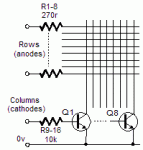trevorboultwood
Member
Hello everyone, little question I will be recieving some led matrix's soon. I have been looking a lot on how to multiplex them(maybe in the future i will get a driver). Any way it is an 8x8 led matrix so 16 pins are needed to multiplex them. I shall use maybe use a double multiplex to cut the io pins needed to 12(I understand the concept but will be very difficult to keep track of the program I create).
Could someone recomend a transistor type? That can both be used for the cathode and anode? And if possible be avaliable from Maplin (I am heading to southampton on saturday and will get a couple to test). Thank you all for reading and again maybe see you in the finished section one day:L =)
Trevor Boultwood
Link to the LED Matrix (from eBay):http://www.ebay.co.uk/itm/320726819510?ssPageName=STRK:MEWNX:IT&_trksid=p3984.m1439.l2649#ht_2742wt_1396
Could someone recomend a transistor type? That can both be used for the cathode and anode? And if possible be avaliable from Maplin (I am heading to southampton on saturday and will get a couple to test). Thank you all for reading and again maybe see you in the finished section one day:L =)
Trevor Boultwood
Link to the LED Matrix (from eBay):http://www.ebay.co.uk/itm/320726819510?ssPageName=STRK:MEWNX:IT&_trksid=p3984.m1439.l2649#ht_2742wt_1396


